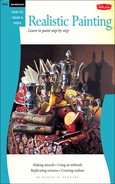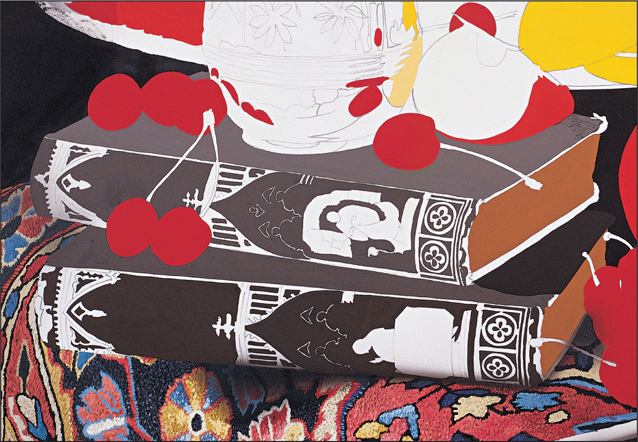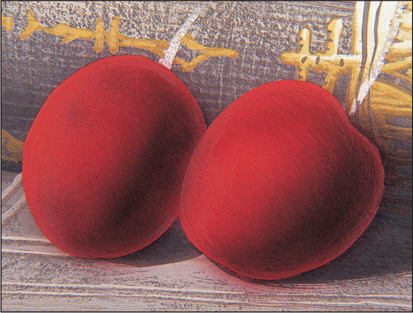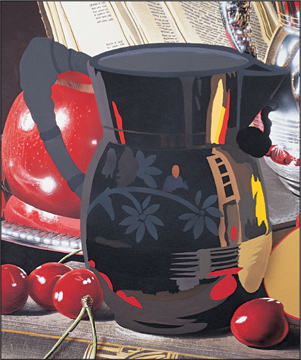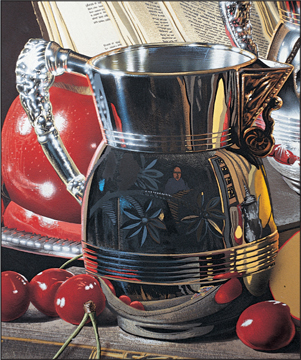DEMONSTRATION: HEIRLOOMS WITH CHERRIES

1 Work out all the details of your composition in a drawing. Then use an HB pencil to transfer your drawing to an eight-ply museum board. The board will be a sturdy support for your painting.

2 Apply ivory black, alizarin crimson, and ultramarine blue gouache to the background with a #4 watercolor brush. Airbrush highlights on the right side using burnt sienna, alizarin crimson, and Naples yellow gouache. Where the shadows overlap, create an even darker shadow with ivory black gouache.

3 Start filling in the patterns of the foreground rug with ivory black and yellow ochre. To judge the other colors you will use later, gauge the darkest color early on in the painting process.

4 Now add other colors to the rug. Take your time perfecting the designs with blues, reds, and browns. Mix each color with a touch of black to make it darker, creating an underpainting for the tapestry.

5 Once the tapestry’s underpainting is finished, bring out the brilliant colors in the patterns. Apply a layer of local color with yellows, blues, and reds. These are the colors the tapestry will remain, except in areas hit by direct light or areas of shadow.

6 Airbrush a dark wash of ivory black and alizarin crimson watercolor over the right side of the rug that is in shadow. Notice how the tapestry details are still visible beneath the wash. Using watercolor over gouache creates very effective shadows.

7 Airbrush highlights with lighter tints of the rug colors. Now paint the book’s pages with yellow ochre and zinc white. Add burnt umber and ivory black to this mixture to airbrush the shadows. Create the writing with ivory black, burnt umber, and zinc white.

8 Paint the lemons and yellow reflections with cadmium yellow. Then add yellow ochre to the lemon on the far right and airbrush it with burnt umber, alizarin crimson water-color, and ivory black. Use cadmium red for the other fruit and red reflections.
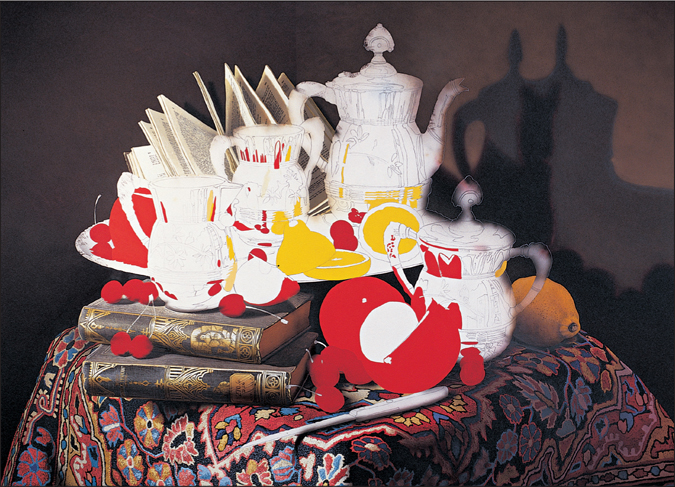
9 Now start defining the two books in the foreground. (See “Books Detail” above and “How to Paint Old Books” on page 14 for more information.)

10 Complete the cherries and apple in the back (see “Cherries Detail” on page 30). Paint the rinds of the middle lemons and apple flesh with a Naples yellow and yellow ochre gouache mix. Then apply pure ivory black to the darkest areas of the silver pieces.
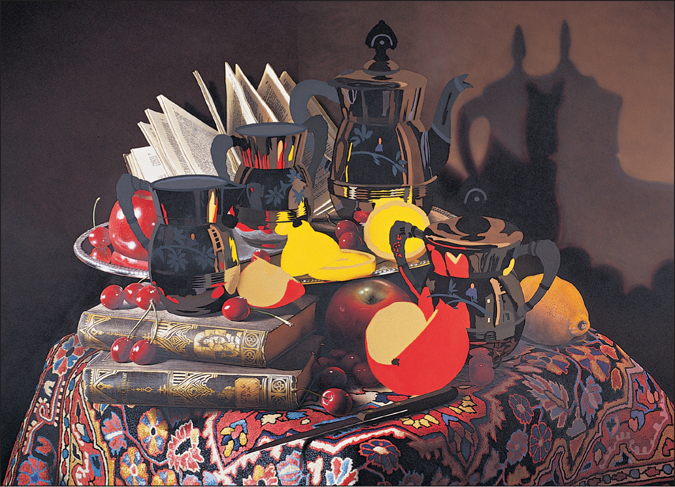
11 Now complete the underpainting for all the silver pieces (see “Silver Detail” step one below). At this point, the entire museum board should be covered with paint and no white from the painting surface should remain. Now it is time to refine the silver pieces; accurately rendering these reflective surfaces is key to creating a sense of realism in this painting.

12 Begin by developing the large teapot in the background and the silver piece to its left (see “Silver Detail” below and “How to Paint Silver” on page 12). Then complete the lemons in the center, painting them with full lighting and airbrushing cast shadows to their right using ivory black watercolor. Add permanent white gouache highlights with a #1 watercolor brush.
13 Now finish the silver piece above the books on the left. (See “Silver Detail” on page 30.) Pay careful attention to the highlights and reflections on the surface of the silver from the objects surrounding it.

STILL LIFE WITH CHERRIES (38 1/2" × 53") gouache on museum board, Private Collection
14 Complete the last silver piece on the right and the cherry in front of it (see “Cherries Detail” on page 30). Then paint the foreground apple and apple slice. The apple’s skin is cadmium red gouache, and the flesh is a mix of yellow ochre and zinc white gouache. The airbrushed shadows on the slice are burnt umber and ivory black watercolors. Next paint the knife to subtly blend in with its surroundings. Tape off the edges of the blade to ensure that they are sharp and clean when you airbrush ivory black watercolor at the base of the blade and zinc white gouache at the tip of the blade. Don’t forget to capture the cherry reflection on the knife blade. For the knife handle, use burnt umber, ivory black, and zinc white gouache for the top. The shaded side of the handle is an ivory black and burnt umber gouache mixture. Now go over all of the white highlights with fresh, clean permanent white to add sparkle to the entire painting. The final step is to proudly add your signature. I actually signed the piece earlier on the spine of the bottom book, but the placement is entirely up to you as long as you include it!
